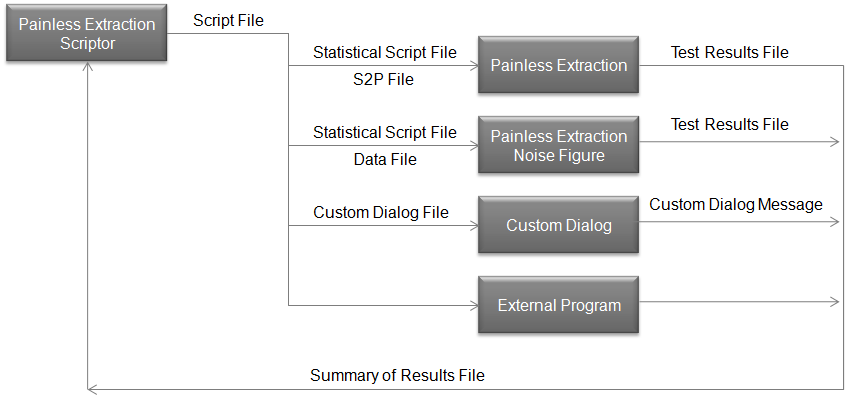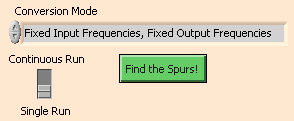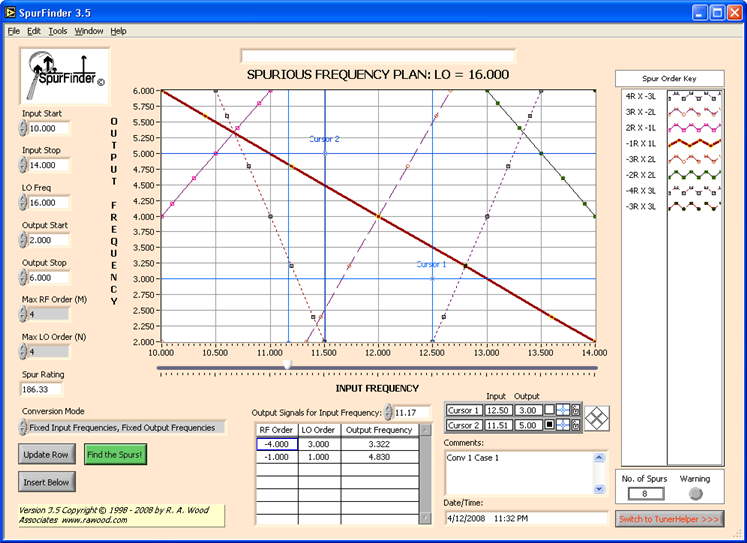Friday, March 26, 2010
Painless Extraction Scriptor 1.0 Released

|
| We have released a new Software Product, called Painless Extraction Sciptor (Version 1.0). This program combines the data extraction and analysis capabilities of Painless Extraction & Painless Extraction Noise Figure with a new Custom Dialog Utility and an External Program Caller in an easy to use interface to automate testing through scripting. This program enables the user to construct script files that will call Painless Extraction, Painless Extraction NF, Custom Dialog Boxes, and External Programs. Use these capabilities in combination to create customized automated testing procedures. For more information, please visit our software download page. |
Edited on: Monday, October 07, 2013 9:50 PM
Categories: 35 Software Products-Current
Monday, March 22, 2010
New Update (2.2) for Painless Extraction Released
We've released a new version of Painless Extraction (2.2) today. This release includes many new features, including:
- Compatibility with HP 8575d Scalar Analyzers
- Compatibility with new Agilent PNA Network Analyzers (will be released in Version 2.2.1 very shortly)
- A new graphical interface panel with plots, statistics, and a pass/fail report, all on the same page
- Capability to be called from Painless Extraction Scriptor, which will allow Painless Extraction to be called remotely from script files (stay tuned for the release of Painless Extraction Scriptor coming soon)
- A self contained macro capability, where multiple plots can be printed with limits. A great way to create a quick test report for each part tested.
Please feel free to visit our software information page for more information. As always, your feedback and suggestions are always welcome!
Edited on: Monday, October 07, 2013 9:51 PM
Categories: 35 Software Products-Current
Tuesday, October 06, 2009
SpurFinder 3.5.2 Update Released

|
We've updated SpurFinder to version 3.5.2. This update fixed a user interface bug: When the program was initially opened, the "Continuous Run/Single Run" selector was hidden from the user interface. This selector didn't reappear until the user opened a "Multi Scenario Script File" from the file menu, and then closed the file. This may have caused some confusion in using the program, which we apologize for. The update is free and can be obtained by downloading the SpurFinder installation files from our Software Download Page. Previously registered software will still be registered during the installation. |
Edited on: Monday, October 07, 2013 9:51 PM
Categories: 35 Software Products-Current
Friday, March 21, 2008
Software Manuals Updated and Uploaded
We have updated and uploaded all our software manuals. Many thanks to Amelia, who has been working very hard to create and update all our manuals, and keep them current with our latest software revisions.
Manuals for:
- SpurFinder
- TunerHelper
- RF Path Analysis Toolkit
- RFSpecTest
- Painless Extraction
- Painless Extraction NF
- PathLossSolver
can be downloaded from our Software Products page. Thanks! Bob Wood
Edited on: Monday, October 07, 2013 8:00 PM
Categories: 35 Software Products-Current
Thursday, March 20, 2008
New SpurFinder Version 3.5 Released!
Hi Everybody!
We just released a new enhanced Version 3.5 of SpurFinder. The new version provides the capability to create/load multi-scenario "script" files. The script files can contain multiple SpurFinder scenarios that can be set up for the purpose of evaluating the best spurious conversion scheme. You can "pre" set up the various spur scenarios using Excel or a text file editor, and then save the file as tab-separated text. With a single click of a line in the table, all the scenario information is transferred to the SpurFinder front panel. This allows the user to quickly evaluate many conversion schemes (without having to type all the parameters in the front panel).
You can also modify the SpurFinder front panel information and save the information back to the multi-scenario script file.
It's simple, just load a Multi Scenario Script File, select a row:

The row information is entered in the SpurFinder Panel:

For more information, go to our software page. Download the program, try it out, and let us know what you think. Thanks! Bob Wood
Edited on: Monday, October 07, 2013 8:01 PM
Categories: 35 Software Products-Current
Monday, October 29, 2007
RF Path Analysis Toolkit 1.4 Released!
We just released an update to RF Path Analysis Toolkit (Version 1.4). The release contains some nice time saving features and improvements:
- Drag and Drop RF Components: In the RF Path Builder display, you can now drag and drop RF components in the path table rows. This makes it easy to move RF components around in the RF path. Previously if you wanted to move an RF component, you had to delete the RF component, and then look it up again in the library to insert it into a new location.
- Sub paths: You can now define an RF Path as a series of sub paths, which are individual RF path files. This saves potential errors and time in updating many RF paths containing the same path information. Previously, you could only manually load sub paths into an RF path file. Now they can be defined within the RF path file itself.
- Export to Excel options: Now you can select the option to leave the detailed RF path analysis spreadsheet open after "Export to Excel" is selected. Previously the detailed RF path analysis spreadsheet was closed after "Export to Excel". This is convenient for viewing the detailed results quickly as you are building RF paths.
- More information in the RF Path Builder display: As you are building an RF path in the RF Path Builder, you can now see the following parameters:
- Device Nominal Gain
- Cumulative Gain to Device Output
- Device Noise Figure
- Cumulative Noise Figure to Device Output
- Signal 1 Power at Device Output
- Signal 2 Power at Device Output
- Device Third Order Output Intercept Point
- Cumulative Third Order Input Intercept Point
- Device 1 dB Output Compression Point
- Signal 2 Delta from Device 1 dB Compression Point
- Third Order Spurs at Device Output (new!)
- Cumulative 1 dB Input Compression Point (new!)
- Path File Save and Load folders: You can now specify the default directory for saving and loading RF path files. Previously this was fixed to the "Level 1" directory.
- Revised template spreadsheets: We've updated and improved the template detailed analysis spreadsheets. There are now two template spreadsheets:
- RFPATTemplate4-2.xls is a simplified (but still very useful) RF path analysis spreadsheets for receivers and transmitters. Antenna gains can not be accurately incorporated into the model. Sensitivity calculations are based on the receiver RF components only.
- RFPATTemplate6-2.xls is a more advanced RF path analysis spreadsheet. This template allows for separate RF component "signal gain" and "noise gain" parameters. This allows the spreadsheet to show radiated sensitivity, because antenna gains can be taken into account (antennas have "signal gain" but no "noise gain"). Basic RF components have the same "signal gain" and "noise gain".
- File Path dialog boxes should be more descriptive and helpful.
- Other changes to the user interface/display to help clarify the operation of the program.
Thanks! -Bob Wood
Edited on: Monday, October 07, 2013 8:00 PM
Categories: 35 Software Products-Current
Monday, July 09, 2007
New Software Support/Documenation Wiki
Hello Everybody
We just wanted to let you know we have set up a Wiki
to document all our software products: SpurFinder, TunerHelper,
PathLossSolver, RF Path Analysis Toolkit, Painless Extraction, Painless
Extraction NF, and RFSpecTest. The WWW address of the software
documentation Wiki is http://helprawoodsoftware.rawood.com/.
This site will be a live, real-time documentation effort. As our software products get updated, the Wiki site gets updated very quickly. No more waiting for manuals to get updated before you know what the new features are. We can quickly add new features in our software, and the software documentation Wiki will let you know what the new features are. Since the site is continuously updated, stopping by again should provide more and better documentation than the previous time.
As always, if you have questions, just let us know, and if you have any suggestions for making the Wiki better, we'd like to hear about that as well.
Thanks for visiting! -Bob Wood
Edited on: Monday, October 07, 2013 8:01 PM
Categories: 35 Software Products-Current
Friday, June 22, 2007
Painless Extraction NF (Noise Figure) just Released!
Do you have one of the classic HP/Agilent HP8970A or HP8970B noise figure meters, but have no way to extract data electronically from the test equipment? Are you tired of outputting data to plotters, or scrolling through the frequencies to determine what the measured noise figures are?
We've just released a new program, Painless Extraction NF, which was developed to retrieve measured gain and noise figure data from the HP8970 series Noise Figure Meter. All you need is a PC GPIB card, or a USB to GPIB connection, and you can connect your laptop or PC up to the noise figure meter, retrieve the measurements, and analyze the results.
Some of the features of this new program are:
- You can enter an ENR table into the program, and send the ENR table to the noise figure meter. You can also save and load ENR table files
- One button to "Get Data" from the noise figure meter
- Once the measurements are retrieved, statistical analysis can be performed over any frequency range of measurements. Statisitics include Average, Min, Max, P-P Variation, Best Fit Line Slope, RMS, Standard Deviation, and others.
- The measured noise figure and gain data can be saved to a data file, which can then be loaded and analyzed using the program. Data is also stored in S2P format for importing noise figure readings into S2P data files for the measured devices
- A test script can be easily defined with frequency ranges and limits. The PASS/FAIL results of the test script can be saved to data files. This is very useful for high volume or "production" testing. An example script might include several tests, such as:
- Is the minimum gain over 300-900 MHz > 20 dB? (Pass/Fail)
- Is the maximum gain over 300-900 MHz < 25 dB? (Pass/Fail)
- Is the maximum noise figure over 500-900 MHz < 5 dB? (Pass/Fail)
For more information, visit our Software Products page. A demo version can be downloaded and you can try out the features of this program. Give it a try, and let us know what you think! Bob Wood
Edited on: Monday, October 07, 2013 8:01 PM
Categories: 35 Software Products-Current
Sunday, February 25, 2007
Demo Version of RFSpecTest Released
Hello Fellow Test Engineers and Managers:
- Are you frustrated with the time and effort required to test your RF and microwave components?
- Are you upset with the errors and mistakes associated with manual testing?
- Is developing your own computer automated test software beyond your budget?
- Do you already have test equipment capable of GPIB control?
- 1, 2, or 3 RF Signal Generators?
- A Spectrum Analyzer?
- An RF Power Meter?
- Wouldn't it be great if there was a software program already developed that could be used right away to start making automated RF measurements?
We have a software program, called RFSpecTest, which has many built-in computer automated RF/microwave tests already developed. We've just created a demonstration version that can be downloaded and evaluated. More information is available from our software information page. Download the demo, and try out the tests and interfaces available. We also have some sample measurement files you can load into the program. Give it a try and let us know what you think!
Thanks! Bob WoodEdited on: Sunday, February 25, 2007 2:35 AM
Categories: 35 Software Products-Current, 70 LabVIEW Examples-Archive
Thursday, September 01, 2005
New scripting features built into RFSpecTest!
This year we added some major enhancements to our "off the shelf" computer automated RF test software suite. RFSpecTest, which was originally designed to work in a laboratory environment through a user interface, has now successfully been made "script-able". This means that all tests you can perform through the user interface in a lab environment can now be performed in an automated test environment. RFSpecTest can be called as a dll to perform all tests (gain, intermodulation products, gain compression, relative isolation, leakage and spurious, etc) from LabVIEW or other programming environments. All test setup parameters can be created and validated in the RFSpecTest user interface. Let us know if you would like additional information (315-735-4217). Thanks! Bob WoodEdited on: Saturday, April 22, 2006 6:38 PM
Categories: 35 Software Products-Current
Wednesday, July 13, 2005
New Leakage/Spurious Test added to RFSpecTest
Hello Everybody. We've added a new RF test to RFSpecTest. Now you can perform Leakage/Spurious measurements in addition to Gain, Gain Compression, Intermodulation Products, Relative Attenuation and Isolation, and Amplitude/Frequency Tests. The Leakage test allows the capability to search frequency bands, with options to skip around the carrier and harmonics, and find the highest spurious or leakage product in the search band. Applications include mixer spurious tests, receiver or transmitter spurious tests, receiver or local oscillator leakage tests. Please call us (315-735-4217) if you would like more information. Thanks! Bob WoodEdited on: Monday, October 07, 2013 7:46 PM
Categories: 35 Software Products-Current
Monday, August 09, 2004
We've added a new Software Support Forum
We've added a new Software Support Forum, where you can post questions or help contribute your expertise for our various software products. We are looking forward to watching this grow and enhance our software user community. Try it out at http://support.rawood.com!Edited on: Saturday, February 05, 2005 8:56 PM
Categories: 35 Software Products-Current